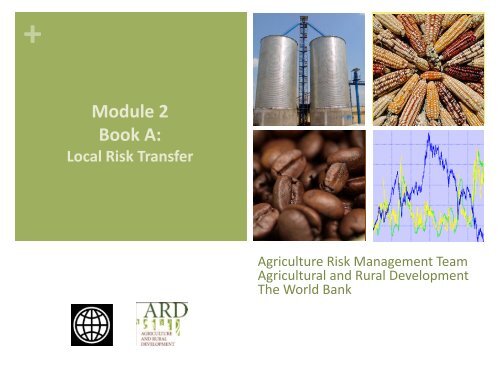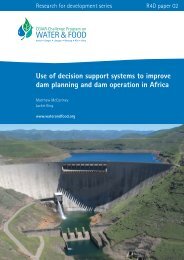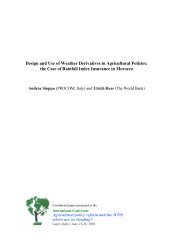Module 2 - Forum for Agricultural Risk Management in Development
Module 2 - Forum for Agricultural Risk Management in Development
Module 2 - Forum for Agricultural Risk Management in Development
Create successful ePaper yourself
Turn your PDF publications into a flip-book with our unique Google optimized e-Paper software.
+<br />
<strong>Module</strong> 2<br />
Book A:<br />
Local <strong>Risk</strong> Transfer<br />
Agriculture <strong>Risk</strong> <strong>Management</strong> Team<br />
<strong>Agricultural</strong> and Rural <strong>Development</strong><br />
The World Bank
+ <strong>Module</strong> 2 Outl<strong>in</strong>e<br />
� A: Local <strong>Risk</strong> Transfer<br />
� Local Markets<br />
� National <strong>Risk</strong> Retention<br />
� Co-<strong>in</strong>surance Pool<br />
� Role of National Insurer<br />
� B: International <strong>Risk</strong> Transfer<br />
� <strong>Risk</strong> Transfer<br />
� The Weather Market<br />
� International Weather Market and Players<br />
� C: <strong>Risk</strong> Layer<strong>in</strong>g<br />
� <strong>Risk</strong> Layer<strong>in</strong>g Via Re-<strong>in</strong>surance<br />
� Role of Government
+ Local Markets<br />
Roles and benefits<br />
� Local (national ) <strong>in</strong>surance companies are critical to weather <strong>in</strong>dex<br />
<strong>in</strong>surance (WII) development and implementation.<br />
� Ma<strong>in</strong> roles of the <strong>in</strong>surer are<br />
� Develop<strong>in</strong>g products (policies), rates and word<strong>in</strong>gs<br />
� Accept<strong>in</strong>g risks, policy issuance, claims payment<br />
� Form<strong>in</strong>g a distribution network and l<strong>in</strong>kages to stakeholders<br />
� Benefits of weather <strong>in</strong>dex <strong>in</strong>surance <strong>for</strong> an <strong>in</strong>surer can <strong>in</strong>clude<br />
� Develop<strong>in</strong>g a profitable new l<strong>in</strong>e of bus<strong>in</strong>ess<br />
� Tapp<strong>in</strong>g <strong>in</strong>to a new client base <strong>in</strong> rural areas<br />
� New product opportunities (e.g. Micro<strong>in</strong>surance) <strong>for</strong> rural clients<br />
� Social responsibility to an under-served market
+ Local Markets<br />
Constra<strong>in</strong>ts and needs<br />
� Challenges <strong>for</strong> <strong>in</strong>surers often <strong>in</strong>clude<br />
� Limited knowledge about agricultural <strong>in</strong>surance (applies especially to WII<br />
products)<br />
� Crop and livestock <strong>in</strong>surance risks are complex and variable<br />
� Investment of time and resources<br />
� Potential <strong>for</strong> scal<strong>in</strong>g up to critical mass<br />
� Needs of the <strong>in</strong>surers normally <strong>in</strong>clude<br />
� Capacity build<strong>in</strong>g <strong>for</strong> managers and staff<br />
� Tra<strong>in</strong><strong>in</strong>g and assistance <strong>in</strong> design<strong>in</strong>g appropriate weather <strong>in</strong>dex product<br />
� Legal and regulatory approval
+ Local Markets<br />
Legal and regulatory requirements<br />
� Index <strong>in</strong>surance will require approval by the <strong>in</strong>surance regulator<br />
� Index <strong>in</strong>surance differs from <strong>in</strong>demnity <strong>in</strong>surance<br />
� Claims are paid based on an weather measurements, not by measur<strong>in</strong>g actual<br />
loss <strong>in</strong> the field<br />
� Payouts will not exactly match the losses suffered, and sufficient correlation<br />
between weather events and losses need to be demonstrated<br />
� May be more difficult to demonstrate an “<strong>in</strong>surable <strong>in</strong>terest”<br />
� For example, was the crop actually sown by the farmer ?<br />
� Generally <strong>in</strong>surance regulators are sympathetic to <strong>in</strong>troduction of <strong>in</strong>dex<br />
<strong>in</strong>surance due to the importance of f<strong>in</strong>d<strong>in</strong>g solutions to meet the needs of<br />
farmers and supply cha<strong>in</strong> participants<br />
� Insurers need to establish dialogue with the regulator and present<br />
proposals, which may <strong>in</strong>itially only be <strong>for</strong> pilot test<strong>in</strong>g of the product
+ National <strong>Risk</strong> Retention<br />
The <strong>in</strong>surer will reta<strong>in</strong> risk but transfer some risk to re<strong>in</strong>surers (module<br />
2B)
+ Co-<strong>in</strong>surance pools<br />
Benefits from <strong>in</strong>surers work<strong>in</strong>g together<br />
� Operational collaboration<br />
� A “market <strong>in</strong>itiative” <strong>for</strong> a new product<br />
� Br<strong>in</strong>g<strong>in</strong>g together key personnel from specific <strong>in</strong>surance companies<br />
� A jo<strong>in</strong>t <strong>in</strong>surance policy is issued, specify<strong>in</strong>g the share of each company<br />
� Frequently a national Insurance Association may represent the <strong>in</strong>dustry<br />
� Shared learn<strong>in</strong>g and capacity build<strong>in</strong>g<br />
� Pool management: lead co-<strong>in</strong>surer or creation of specialist underwrit<strong>in</strong>g agency<br />
� F<strong>in</strong>ancial collaboration<br />
� Increas<strong>in</strong>g the f<strong>in</strong>ancial retention of the national market compared to <strong>in</strong>dividual<br />
<strong>in</strong>surers<br />
� Shared (pooled) adm<strong>in</strong>istration and operat<strong>in</strong>g functions (cost sav<strong>in</strong>gs)<br />
� Opportunity to purchase pooled re<strong>in</strong>surance (cost sav<strong>in</strong>gs)<br />
� Adoption of standard products, rates and loss assessment procedures by<br />
co<strong>in</strong>surance pool members
+ Co-<strong>in</strong>surance pools<br />
� Co-<strong>in</strong>surance pools have some disadvantages<br />
� A clear leader must be specified, who is responsible <strong>for</strong> decisions on<br />
underwrit<strong>in</strong>g the risk. Other co-<strong>in</strong>surers agree to follow the leader<br />
� It may not be acceptable where one <strong>in</strong>surer has made major <strong>in</strong>vestments,<br />
but all other <strong>in</strong>surers participate <strong>in</strong> premium and claims pro-rata<br />
� A co-<strong>in</strong>surance pool can limit competition and market development. It<br />
may suit the first stage of develop<strong>in</strong>g a program<br />
� Different agricultural co-<strong>in</strong>surance models have developed.<br />
� Co<strong>in</strong>surance agreements with appo<strong>in</strong>ted lead <strong>in</strong>surer: Malawi, Mongolia,<br />
Ch<strong>in</strong>a, Ukra<strong>in</strong>e, South Korea<br />
� Specialist Agencies or Manag<strong>in</strong>g Underwriter’s: Agroseguro (Spa<strong>in</strong>),<br />
TARSIM (Turkey).
+ Demand <strong>for</strong> Weather Index Insurance<br />
<strong>Risk</strong> management needs at different levels of aggregation<br />
Client needs from weather exposure can be:<br />
� Micro level<br />
� Insurance <strong>for</strong> farmers and rural households<br />
� Meso level<br />
� Insurance <strong>for</strong> processors, packers, banks, traders<br />
� Those at risk of supply shortfall, contractual defaults<br />
� Banks at risk of <strong>in</strong>ability of clients to repay loans<br />
� Macro level<br />
� Governments, food security, major corporations, and those with<br />
f<strong>in</strong>ancial need to respond to weather-<strong>in</strong>duced disaster
+ Role of the national <strong>in</strong>surer(s)<br />
Summary<br />
� The national <strong>in</strong>surer(s) plays an central role <strong>in</strong> WII.<br />
� The ma<strong>in</strong> responsibilities of the national <strong>in</strong>surer <strong>in</strong>clude:<br />
� Design<strong>in</strong>g and adapt<strong>in</strong>g the product to meet client needs<br />
� Form<strong>in</strong>g stakeholder relationships, particularly <strong>for</strong> distribution<br />
� Issu<strong>in</strong>g the <strong>in</strong>surance contract<br />
� Collaborat<strong>in</strong>g <strong>in</strong> the extension and monitor<strong>in</strong>g of the product<br />
� Arrang<strong>in</strong>g re<strong>in</strong>surance<br />
� Pay<strong>in</strong>g claims promptly<br />
� National <strong>in</strong>surers may benefit through opportunities <strong>for</strong> other rural<br />
<strong>in</strong>surance or micro<strong>in</strong>surance bus<strong>in</strong>ess, as a result of develop<strong>in</strong>g a<br />
rural clientele and distribution outlets.
+<br />
<strong>Module</strong> 2<br />
Book B:<br />
International <strong>Risk</strong> Transfer<br />
Agriculture <strong>Risk</strong> <strong>Management</strong> Team<br />
<strong>Agricultural</strong> and Rural <strong>Development</strong><br />
The World Bank
+ <strong>Module</strong> 2 Outl<strong>in</strong>e<br />
� A: Local <strong>Risk</strong> Transfer<br />
� Local Markets<br />
� National <strong>Risk</strong> Retention<br />
� Co-<strong>in</strong>surance Pool<br />
� Role of National Insurer<br />
� B: International <strong>Risk</strong> Transfer<br />
� <strong>Risk</strong> Transfer<br />
� The Weather Market<br />
� International Weather Market and Players<br />
� C: <strong>Risk</strong> Layer<strong>in</strong>g<br />
� <strong>Risk</strong> Layer<strong>in</strong>g Via Re-<strong>in</strong>surance<br />
� Role of Government
+ <strong>Risk</strong> transfer<br />
Why transfer risk ?<br />
� Provides an effective access to a larger capital base <strong>for</strong> a national<br />
<strong>in</strong>surance company<br />
� Weather <strong>in</strong>surance risks are not “<strong>in</strong>dependent”, and large numbers of<br />
clients can be affected simultaneously (“covariant” risks). This demands<br />
relatively larger access to <strong>in</strong>surance capital compared to a portfolio of<br />
<strong>in</strong>dependent risks<br />
� Understand<strong>in</strong>g f<strong>in</strong>ancial impact of weather risk on an <strong>in</strong>sured portfolio is<br />
the start<strong>in</strong>g po<strong>in</strong>t <strong>for</strong> plann<strong>in</strong>g risk retention and risk transfer<br />
� There is a grow<strong>in</strong>g market which is will<strong>in</strong>g to accept WII risks, and<br />
<strong>in</strong>creas<strong>in</strong>g understand<strong>in</strong>g of opportunities and constra<strong>in</strong>ts of WII<br />
� Re<strong>in</strong>surance should lead to f<strong>in</strong>ancial solvency and susta<strong>in</strong>ability of a WII<br />
scheme
+ The Weather Market<br />
A brief history (1)<br />
� Weather derivatives orig<strong>in</strong>ated <strong>in</strong> the USA around 1997; energy<br />
utilities were exposed to high volatility of supply and demand due to<br />
weather<br />
� Increas<strong>in</strong>g volumes of “over-the-counter” (OTC) transactions led to<br />
the development of present day derivative markets, where weather<br />
risks are traded (e.g. Chicago Mercantile Exchange, CME).<br />
� Weather derivatives are ma<strong>in</strong>ly used by large corporates, but<br />
<strong>in</strong>creas<strong>in</strong>gly by agribus<strong>in</strong>ess, retail and construction firms<br />
� Larger re<strong>in</strong>surers are <strong>in</strong>volved <strong>in</strong> weather risk transfer, both as<br />
re<strong>in</strong>surance contracts and as derivatives.<br />
� Examples of the diversity of weather risk transfer applications can be<br />
found on the WRMA website www.wrma.org
+ The Weather Market<br />
A brief history –(2)<br />
� Insurers have offered weather event cancellation <strong>in</strong>surance <strong>for</strong> many years<br />
� Example: Costs of cancellation of sport<strong>in</strong>g events if ra<strong>in</strong>fall exceeds a daily threshold<br />
� Innovative retail agencies and brokers have greatly developed the product range<br />
� Examples: Cumulative snow amounts <strong>in</strong> ski resorts: Number of days with low<br />
temperature affect<strong>in</strong>g ice cream sales....<br />
� A few agencies <strong>in</strong> high <strong>in</strong>come countries have offered products <strong>for</strong> agriculture<br />
� For WII <strong>in</strong> develop<strong>in</strong>g countries, re<strong>in</strong>surance (rather than derivatives) is the<br />
ma<strong>in</strong> contractual basis <strong>for</strong> risk transfer from <strong>in</strong>surers<br />
� Re<strong>in</strong>surers: The <strong>in</strong>ternational re<strong>in</strong>surance market is dom<strong>in</strong>ated by the large,<br />
consolidated companies with global outreach :<br />
� Munich Re, Swiss Re, ACE, Partner Re (which recently acquired Paris Re) are the<br />
pr<strong>in</strong>cipal markets <strong>for</strong> re<strong>in</strong>surance of agri WII<br />
� A very large global re<strong>in</strong>surance market exists <strong>for</strong> traditional <strong>in</strong>demnity based<br />
agricultural <strong>in</strong>surance (estimated market <strong>in</strong>surance premium volume approx. $20<br />
billion)
+<br />
2009 Global agricultural <strong>in</strong>surance<br />
premiums US$ 19.4 billion<br />
USA & Canada, US$ 10,700 Million (55,1%)<br />
Lat<strong>in</strong> America, US$ 720 Million (3.7%)<br />
Source: Iturrioz 2010; Mahul & Stutley 2010<br />
Europe, US$ 3,900 Million (20.1%)<br />
Africa, US$ 100 Million (0,5%)<br />
Asia, US$ 3,800 Million (19,6%)<br />
Oceana, US$ 200 Million (1.0%)
+ Global agricultural <strong>in</strong>surance products<br />
(2009 share of global premium US$ 19.4 billion)<br />
2<br />
Aquaculture,<br />
1%<br />
Livestock, 12%<br />
Source: Iturrioz 2010<br />
Bloodstock 2% Forestry, 1% Greenhouses,<br />
1%<br />
Crop/Hail, 15%<br />
Crop/MPCI,<br />
68%
+ Demand is high <strong>in</strong> low and middle <strong>in</strong>come countries<br />
AGRICULTURAL WEATHER INDEX INSURANCE MARKET DEVELOPMENT<br />
WII premium approx $100m (exclud<strong>in</strong>g Europe and N. America)
+ WII has been available s<strong>in</strong>ce 2003: more that 20<br />
countries are implement<strong>in</strong>g WII (ma<strong>in</strong>ly pilots)<br />
Source: IFAD-WFP, 2010<br />
19
+ International WII services<br />
� Other service providers support<strong>in</strong>g weather <strong>in</strong>surance <strong>in</strong>clude<br />
� Re<strong>in</strong>surance brokers<br />
� Weather data clean<strong>in</strong>g,<br />
� Weather measurement equipment (e.g. automatic stations)<br />
� Analytical, crop prediction and related services<br />
� Consultancy<br />
� <strong>Development</strong> banks and agencies (<strong>in</strong>ternational and national) have<br />
promoted many <strong>in</strong>itiatives and stimulated growth of a service market<br />
� Academic <strong>in</strong>stitutions have taken a strong <strong>in</strong>terest <strong>in</strong> <strong>in</strong>dex <strong>in</strong>surance,<br />
<strong>in</strong>clud<strong>in</strong>g <strong>in</strong> its evaluation
+<br />
<strong>Module</strong> 2<br />
Book C:<br />
<strong>Risk</strong> Layer<strong>in</strong>g<br />
Agriculture <strong>Risk</strong> <strong>Management</strong> Team<br />
<strong>Agricultural</strong> and Rural <strong>Development</strong><br />
The World Bank
+ <strong>Module</strong> 2 Outl<strong>in</strong>e<br />
� A: Local <strong>Risk</strong> Transfer<br />
� Local Markets<br />
� National <strong>Risk</strong> Retention<br />
� Co-<strong>in</strong>surance Pool<br />
� Role of National Insurer<br />
� B: International <strong>Risk</strong> Transfer<br />
� <strong>Risk</strong> Transfer<br />
� The Weather Market<br />
� International Weather Market and Players<br />
� C: <strong>Risk</strong> Layer<strong>in</strong>g<br />
� <strong>Risk</strong> Layer<strong>in</strong>g Via Re-<strong>in</strong>surance<br />
� Role of Government
+ <strong>Risk</strong> layer<strong>in</strong>g via re<strong>in</strong>surance<br />
� In design<strong>in</strong>g an <strong>in</strong>surance scheme, the annual aggregate losses of the<br />
<strong>in</strong>surer can be divided <strong>in</strong>to expected frequency and severity of losses
+ An example of risk layer<strong>in</strong>g<br />
Probability of<br />
occurrence<br />
per number of<br />
years<br />
Up to 100 years Government Re<strong>in</strong>surance of last resort<br />
20-30 years Stop Loss Re<strong>in</strong>surance layer(s)<br />
5-7 years<br />
National Insurance or co<strong>in</strong>surance<br />
(pool of <strong>in</strong>surers)<br />
3-5 years <strong>Risk</strong> Retention by Client<br />
Quota share<br />
re<strong>in</strong>surance
+ Re<strong>in</strong>surance strategy<br />
� Several factors will determ<strong>in</strong>e the amount of risk which the national<br />
<strong>in</strong>surer(s) reta<strong>in</strong>, and the amount transferred to re<strong>in</strong>surance<br />
� The risk profile: expected frequency and severity of annual result<br />
� The aggregate values at risk (e.g. pilot versus full scale operation)<br />
� Appetite of the <strong>in</strong>surer <strong>for</strong> risk<br />
� The availability and access to <strong>in</strong>ternational re<strong>in</strong>surance capacity<br />
� Regulatory considerations<br />
� Re<strong>in</strong>surers also have their own perspective<br />
� They will be <strong>in</strong>terested if there is future growth potential<br />
� In pilot phases, transactions may be too small to be economic<br />
� The <strong>in</strong>surer may be seek<strong>in</strong>g technical guidance from the re<strong>in</strong>surer as much<br />
as f<strong>in</strong>ancial capacity, which is an additional cost to the re<strong>in</strong>surer<br />
� Client relationships on WII may open opportunities to other bus<strong>in</strong>ess l<strong>in</strong>es
+ Quota share re<strong>in</strong>surance<br />
� Quota share re<strong>in</strong>surance is the simplest <strong>for</strong>m<br />
of re<strong>in</strong>surance<br />
� Proportional shar<strong>in</strong>g of risk (premium and<br />
claims)<br />
� Re<strong>in</strong>surer allows the <strong>in</strong>surer a ced<strong>in</strong>g<br />
commission, to recognise the costs of<br />
adm<strong>in</strong>istration and commission paid by<br />
the <strong>in</strong>surer to distribution channels<br />
� The re<strong>in</strong>surer “follows the <strong>for</strong>tunes” of<br />
the <strong>in</strong>surer, which is often fairest at the<br />
start-up phase, when there are many<br />
uncerta<strong>in</strong>ties<br />
� The re<strong>in</strong>surer may require that the<br />
<strong>in</strong>surer does reta<strong>in</strong> a percentage of the<br />
risk – typically at least 10% - to ensure an<br />
<strong>in</strong>centive rema<strong>in</strong>s <strong>for</strong> sound underwrit<strong>in</strong>g<br />
� Frequently there is both quota share and<br />
stop loss re<strong>in</strong>surance <strong>in</strong> place <strong>for</strong><br />
agricultural risks.
+ Stop-Loss re<strong>in</strong>surance<br />
� Stop Loss re<strong>in</strong>surance is also a common <strong>for</strong>m of<br />
agricultural re<strong>in</strong>surance<br />
� Non-Proportional shar<strong>in</strong>g of risk.<br />
� Excess po<strong>in</strong>t (“priority”) and “limit” of<br />
payments under the re<strong>in</strong>surance contract are<br />
expressed <strong>in</strong> terms of Loss Ratio (aggregate<br />
claims divided by aggregate premiums):<br />
example, a layer of 100%, excess of 120%, of<br />
gross premium <strong>in</strong>come<br />
� The priority will be set so that the <strong>in</strong>surer is<br />
<strong>in</strong> deficit at that po<strong>in</strong>t, and may also be<br />
required to reta<strong>in</strong> some risk <strong>in</strong> the layer<br />
� Premiums are set accord<strong>in</strong>g to the expected<br />
claims costs fall<strong>in</strong>g to the layer, with a marg<strong>in</strong><br />
to re<strong>in</strong>surers <strong>for</strong> profit and uncerta<strong>in</strong>ty<br />
� High layers of stop loss are more difficult to<br />
price, as there is less certa<strong>in</strong>ty about<br />
<strong>in</strong>frequent but large events. Higher profit<br />
marg<strong>in</strong>s are required by re<strong>in</strong>surers <strong>for</strong> high<br />
layers
+<br />
3 Examples of Crop Insurance and<br />
Re<strong>in</strong>surance Programs
+ Malawi – Private Sector Quota Share Re<strong>in</strong>surance<br />
Malawi Micro-Level Crop<br />
Weather Index Insurance<br />
Scheme s<strong>in</strong>ce 2005:<br />
� Ra<strong>in</strong>fall deficit Index <strong>for</strong><br />
Groundnuts, Maize and most<br />
recently tobacco<br />
� Co<strong>in</strong>surance Pool of 8 local<br />
<strong>in</strong>surers (Insurance<br />
Association of Malawi)<br />
� Program was not re<strong>in</strong>sured <strong>in</strong><br />
2005-06 and 2006-07 on<br />
account of small scale and low<br />
liability<br />
� Re<strong>in</strong>surance s<strong>in</strong>ce 2007-08<br />
� 80% Quote Share cession to<br />
SwissRe and MunichRe<br />
29
+ India – Public Sector Crop Stop Loss Re<strong>in</strong>surance<br />
National <strong>Agricultural</strong> Insurance<br />
Scheme (NAIS) is re<strong>in</strong>sured by<br />
GOI/State Governments:<br />
� Food Crops <strong>for</strong> losses >100%<br />
Loss Ratio<br />
� Commercial & Horticultural<br />
Crops, <strong>for</strong> losses >150% Loss<br />
Ratio<br />
� Government protection is open<br />
ended (no Loss Limit)<br />
� Stop Loss protection is “free of<br />
charge” to AICI (<strong>Agricultural</strong><br />
Insurance Company India)<br />
� GOI / State governments share<br />
claims on Stop Loss on 50 : 50<br />
basis<br />
� Cost to Government <strong>for</strong><br />
re<strong>in</strong>sured claims <strong>in</strong> 2005, US$<br />
166 million<br />
30
South Korea: Co<strong>in</strong>surance Pool Quota Share plus<br />
Stop Loss with Catastrophe Government protection<br />
� National <strong>Agricultural</strong> Cooperative<br />
Federation (NACF) led Pool Crop<br />
Insurance s<strong>in</strong>ce 2000<br />
� International Re<strong>in</strong>surers<br />
withdrew after major typhoon<br />
losses <strong>in</strong> 2002 and 2003<br />
� Government has capped losses ><br />
180% LR s<strong>in</strong>ce 2005<br />
� S<strong>in</strong>ce 2005 <strong>in</strong>ternational<br />
re<strong>in</strong>surers have re-entered with<br />
Quota Share and Stop Loss<br />
Re<strong>in</strong>surance capacity up to 180%<br />
LR<br />
31
+ Role of government<br />
� Governments are <strong>in</strong>terested <strong>in</strong> support<strong>in</strong>g agricultural <strong>in</strong>surance as a<br />
policy <strong>in</strong>strument. This may take the <strong>for</strong>m of premium subsidy,<br />
support <strong>for</strong> loss assessment, weather <strong>in</strong>frastructure, or<br />
adm<strong>in</strong>istrative costs, re<strong>in</strong>surance, research or development costs<br />
� Public private partnerships are recognised as necessary to harness<br />
market-based <strong>in</strong>surance discipl<strong>in</strong>e, <strong>in</strong>volve stakeholders, and to allow<br />
government <strong>in</strong>terventions to be structured<br />
� Extremely high stop loss layers carry high re<strong>in</strong>surance premiums <strong>in</strong><br />
relation to expected losses at that level. Top layer(s) re<strong>in</strong>surance<br />
may better be provided by governments, or may <strong>for</strong>m part of<br />
f<strong>in</strong>ancial <strong>in</strong>struments, such as triggered cont<strong>in</strong>gent loans, negotiated<br />
between government and <strong>in</strong>ternational development <strong>in</strong>stitutions





